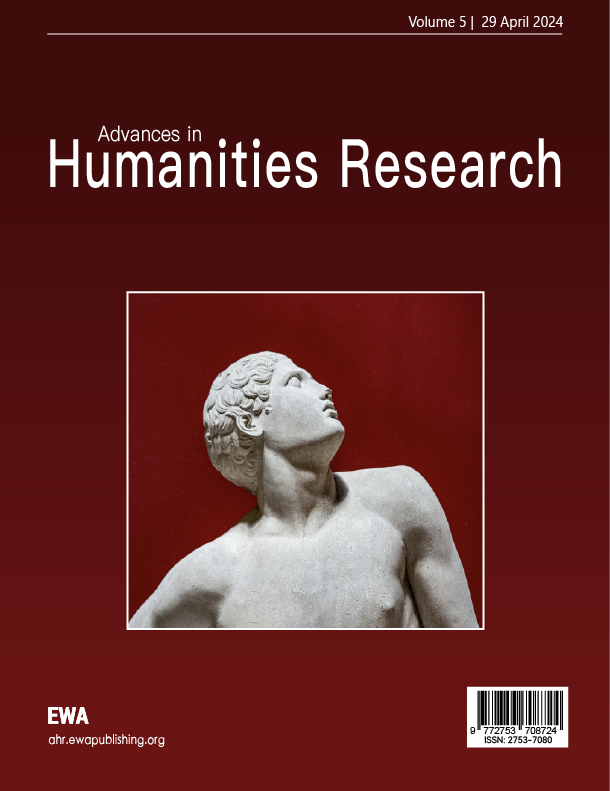

About AHRAdvances in Humanities Research (AHR) is an international peer reviewed journal published by EWA Publishing. AHR is published irregularly. AHR publishes only original articles from a wide variety of methodological and disciplinary perspectives concerning humanities issues. The journal aims to improve the human condition by providing a public forum for discussion and debate about linguistics, literature, art, history and philosophy issues. The journal publishes articles that are research-oriented and welcomes empirical and theoretical articles concerning micro, meso, and macro phenomena. Manuscripts that are suitable for publication in the AHR cover domains on various perspectives of linguistics, literature, art, history, philosophy and their impact on individuals, businesses and society.For more details of the AHR scope, please refer to the Aim&Scope page. For more information about the journal, please refer to the FAQ page or contact info@ewapublishing.org. |
| Aims & scope of AHR are: ·Community, Society & Culture ·Literature ·Art ·Philosophy |
Article processing charge
A one-time Article Processing Charge (APC) of 450 USD (US Dollars) applies to papers accepted after peer review. excluding taxes.
Open access policy
This is an open access journal which means that all content is freely available without charge to the user or his/her institution. (CC BY 4.0 license).
Your rights
These licenses afford authors copyright while enabling the public to reuse and adapt the content.
Peer-review process
Our blind and multi-reviewer process ensures that all articles are rigorously evaluated based on their intellectual merit and contribution to the field.
Editors View full editorial board

Sialkot, Pakistan
nasir.mahmood@uskt.edu.pk

Huntsville, US
mallen@shsu.edu

Beijing, China
fan-yy13@tsinghua.org.cn

Sydney, Australia
yu.sang@sydney.edu.au
Latest articles View all articles
Ernst Bloch, as a pivotal figure in early Western Marxism, constructed his philosophy of hope centered on the ontology of ‘not-yet-being’ (noch-nicht-sein), offering a groundbreaking perspective for traditional philosophical systems. This study traces the conceptual history of his system, analyzes Bloch's original texts, and compares his thought with other Marxist scholars to reveal the uniqueness of his ontology: beyond the binary opposition of being and non-being, Bloch introduces ‘not-yet-being' as a dynamic, processual concept, redefining existence as a perpetually unfolding and incomplete state. This ontology synthesizes the Left Aristotelian theory of potentiality, the openness of Hegelian dialectics, and Marx’s historical materialism, forming a generative logic of ‘nothingness-not-yet-all.’ Bloch’s system not only deconstructs ontological closure but also, through the concept of an ‘open cosmos,’ interprets cultural phenomena as unfinished processes imbued with utopian impulses, endowing them with dual significance for both understanding and transforming the world. This paper argues that Bloch’s open system responds to the 20th-century crisis of spirit while providing methodological insights for contemporary systems research. By emphasizing indeterminacy and possibility, his philosophy pioneers a path for constructing autonomous knowledge systems beyond Euro-centrism, offering critical inspiration for transcending metaphysical constraints and engaging with multicultural realities.

 View pdf
View pdf


This thesis primarily discusses buildings as they exist within collective memories rather than as physical structures grounded in historical facts. From 1958 to 1960, amidst nationwide debates on "What is communist architecture and lifestyle?", the Fusuijing Building, designed by Changru Zhang, was constructed in the northwest corner of Beijing, China. Today, it is also referred to as the "Communist Mansion", a designation that partially obscures its multifaceted history. This research attempts to switch the microphone of the mainstream narrative embedded on the spatial and political scale to the local memories and social voices that are often overlooked. Starting from the perspective of the original residents of the Fusuijing Building, it employs collective memory as a methodological framework. Based on the original design archives of the Fusuijing Building, it translates the collective memories of the original residents into architectural language and conducts imaginative speculative architectural drawings. This process reconstructs a "disappeared" yet enduring social vision within the Fusuijing Building, reimagining it through the lens of collective memory. My research will provide a bottom-up vision for the investigation and renovation of historical buildings in Chinese cities.

 View pdf
View pdf


Reception aesthetics posits that audiences are not passive recipients of information but active participants in the interpretation and creation of films. From the perspective of reception aesthetics, the interactive relationship between audiences and films can be explored more comprehensively. This approach enables an analysis of how films derive vitality and meaning through audience interaction, reveals the socio-cultural connotations and aesthetic value of cinematic art, and examines the variations in audience reception across different social, historical, and cultural contexts. Ultimately, by drawing on the theories and methodologies of reception aesthetics, new narrative techniques and expressive methods in filmmaking can be explored, fostering continuous innovation and development in film art to meet the growing spiritual and cultural needs of audiences. "Big Fish" blends reality and fantasy, incorporating a wealth of emotional elements into its surreal and imaginative cinematic style. This allows audiences to navigate between fantasy and reality, experiencing profound emotional resonance. From the perspective of reception aesthetics, Big Fish successfully triggers aesthetic expectations and facilitates aesthetic communication between the audience and the film through its diverse expressive techniques and unique artistic style, thereby contributing to a rich and varied cinematic art.

 View pdf
View pdf


This study explores the interaction mechanism between language training and cultural transmission in Chinese second language teaching in the context of globalization. This paper analyzes the phenomenon of classroom cultural conflicts from an intercultural perspective, and proposes the teaching strategy to equip the teaching of language knowledge and the cultivation of cultural cognition. Based on the quantitative data of more than 300 learners and the qualitative materials of classroom observation and teacher interviews, the study revealed a significant positive correlation between cultural aptitude and language achievement (r = 0.48). Classes with a culturally responsive approach saw a 27% increase in student engagement and a 34% decrease in cultural misreading. For example, after integrating calligraphy experience into Chinese character teaching, students' font memory accuracy increased by 19%. The research results provide an empirical basis for Chinese international educational institutions, and suggest adding intercultural teaching design modules into teacher training and developing a three-dimensional curriculum system including cultural scenario simulation.

 View pdf
View pdf


Volumes View all volumes
Announcements View all announcements
Advances in Humanities Research
We pledge to our journal community:
We're committed: we put diversity and inclusion at the heart of our activities...
Advances in Humanities Research
The statements, opinions and data contained in the journal Advances in Humanities Research (AHR) are solely those of the individual authors and contributors...
Indexing
The published articles will be submitted to following databases below:






